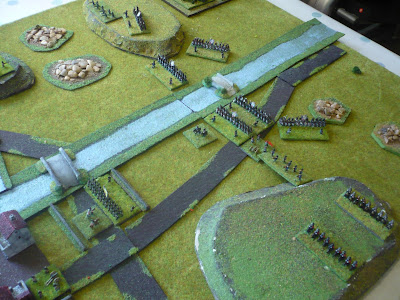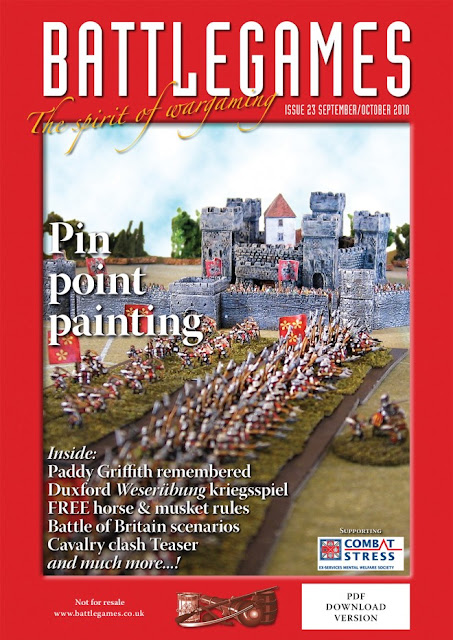The basic idea of the scenario is for the Austrians to prevent the French from exiting any units off the Western side of the table.
French Forces:
6 Infantry battalions
2 Light infantry units
2 Cavalry regiments (1 of Dragoons, 1 of Hussars)
1 Artillery battery
Austrian Forces:
3 Infantry battalions
1 Light Infantry unit
1 Cavalry regiment (Dragoons)
1 Artillery battery
The rules used were Neil Thomas' "Simplicity in Practice" rules published in Battlegames 023.
I have made some amendments to the close combat procedure, as detailed in previous posts. I also used Kaptain Kobold's Napoleonic amendments. In addition I used each side's commander to give a bonus in close combat and to give a morale save (more later).
The Deployment
 |
| View along the river from behind the Austrian reserve. |
 |
| View along the river from behind the advancing French troops. |
 |
| In accordance with their orders, the French troops advance to the line between the two hills and clear the first bridge. |
 |
| The artillery begin to exchange fire, causing losses to each side by the counter-battery fire. |
 |
| The superior French numbers tell and the Austrian defenders on the left bank are eliminated. |
 |
| Same position, from behind the Austrian lines |
 |
| The wider position at this point in time. Note the French reserves coming up on the Southern bank. |
 |
| A smart bayonet charge by the Austrian infantry gains some time on the North bank |
 |
| But the French infantry finally take the southern half of Olleyberg... |
 |
| ...and clear through the village. However, the French cavalry has failed to dislodge the Austrian Dragoons and have been thrown back with loss in their turn |
 |
| And a second charge throws back the French Hussars too! |
 |
| Returning to the fray, the French Dragoons reverse the result! The game is effectively over here, as the Austrians cannot stop the French now on this flank |
 |
| The French converge on the northern bank of Olleyberg, still bravely held by the Austrian light infantrymen. |
The game worked well, no problems. I used the leader to give a saving roll for taking disruption points; 4-6 meaning that a unit accompanied by the commander ignores that DP. However, if the unit accompanied by the leader takes a DP, then the leader has a 1-in-6 chance of becoming a casualty and causing a further DP loss to the unit. As it happens, no chance occurred to try out the "forming square" Napoleonic variant. It can't be emphasized enough that the simplicity of Neil Thomas' rules means that the player spends almost no time dealing with the "mechanics" of the game - everything is either tactical thinking or combat calculation. That said, there are a couple of elements I'd like to experiment with: an alternative to written orders and some kind of formation morale rules.
Figures by Baccus 6mm, buildings by Total Battle Miniatures and Leven Miniatures, game played on a 3'x2' board.







No comments:
Post a Comment